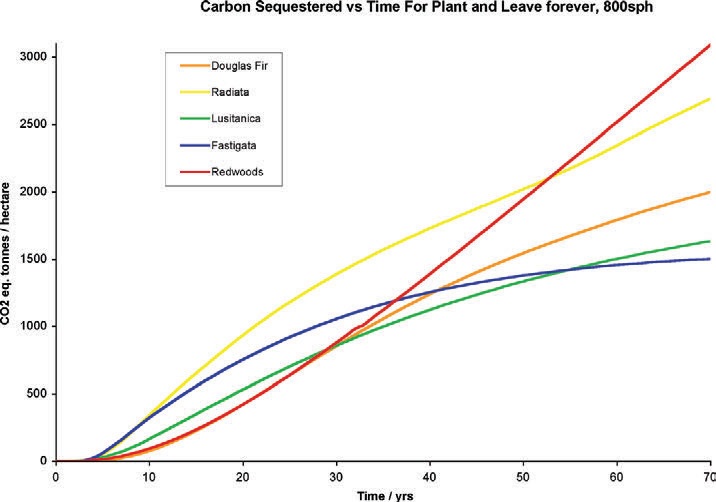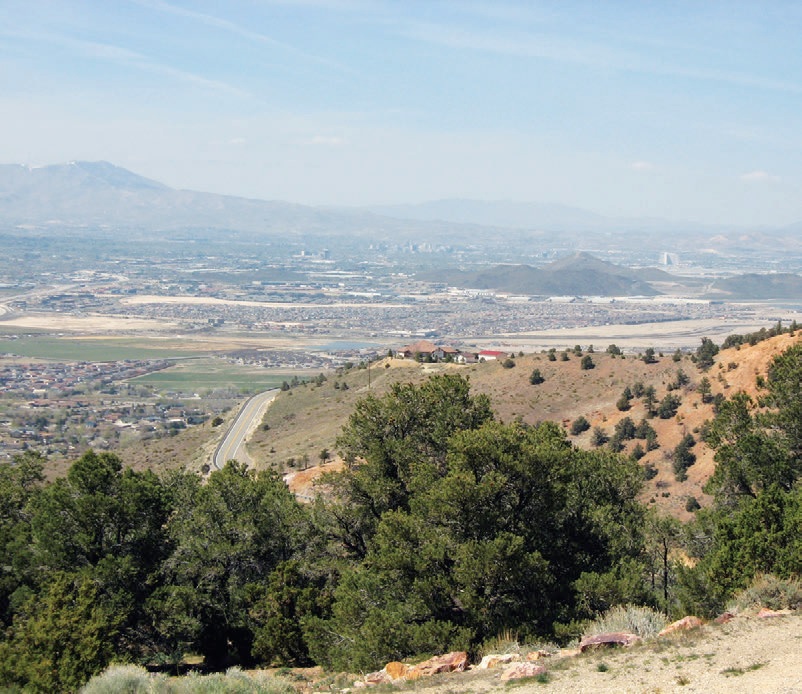Coast redwood the ideal carbon crop
Clayton Wallwork and Simon Rapley, New Zealand Tree Grower November 2009.
It is now time to include carbon as an integral part of the forestry equation. We he have had announcements confirming the Emissions Trading Scheme (ETS) and a significant sale of forestry carbon credits into Europe.
Claiming and selling carbon credits adds another revenue stream to make forestry more attractive than just the sale of timber. However with these added values there are also higher risks. There are sensible ways of managing the risks but they require a new approach to forest management which maximises the returns while at the same time minimising the risks. These techniques include the use of alternative harvesting methods and the use of non-traditional forestry species, such as coast redwood.
The planting of coast redwood, Sequoia sempervirens, is gaining momentum in New Zealand as a viable forestry species due to its high value timber. Redwood also has a number of characteristics that lends itself readily to new forest management techniques.
Carbon forest management
When managing forests for carbon either under the Permanent Forest Sink Initiative (PFSI) or the general forestry provisions of the ETS, it is wise to undertake harvesting in a way that does not incur a liability at the time of harvest.
Under the ETS at the point of harvest a forest owner is liable to pay back any carbon claimed. This is equivalent to the log volume harvested. It involves maintaining a base volume of stock and only harvesting what is sustainable, or harvesting at levels above your base carbon stock.
This can be achieved with either a large mixed aged forest where you are harvesting one area while the rest of the estate is growing, or at a smaller scale having a forest which is amenable to selective or continuous cover harvesting. For example, where the annual increment of an older fast growing redwood forest is 30 cubic metres a hectare per year this volume could be extracted without incurring a liability.
Under the PFSI 30 cubic metres would need to be harvested from each hectare, whereas under the ETS this volume could be combined and harvested in larger parcels, say 300 cubic metres from a section of a 10 hectare stand. There are other variations of managing forests to harvest timber and minimise carbon liabilities. In this issue of the Tree Grower on page 7 there is a case study by Paul Silcock of New Zealand Forestry Ltd which details one such scenario.
Continuous cover forestry
Continuous cover forestry involves, as the name suggests, maintaining a constant canopy, giving the forest a permanent look and feel. The way to achieve a continuous canopy is to harvest small groups of trees within a forest. This can either be done with helicopters or by using a network of tracks within the forest that allows smaller harvesting machinery which has the ability to manoeuvre through existing stands and pull logs to the tracks.
This kind of harvesting is more expensive than traditional clear felling because of the added skills and extra handling required. Therefore continuous cover forestry is more economically viable if the timber is of a higher value to cover these extra costs. Continuous cover forestry is more suited to a species that can replace itself in low light conditions, as the other tall mature trees intercept most of the light. Coast redwood is one such species as it coppices after harvesting and grows in lower light levels than other common forest species. For example, redwood requires only half the light of Douglas fir to maintain growth.
Growth profile
The amount of carbon dioxide absorbed from forests is directly related to the amount of growth of that forest. The faster a forest grows the more carbon you can claim, and the longer it continues to grow and put on additional volume the longer you can claim carbon. The growth profile of coast redwood is ideally suited to carbon.

Coast redwood has the ability to grow as fast as radiata pine on good sites and will continue to grow in volume for hundreds of years. The graph below shows redwood steadily growing for a longer period and accumulating more carbon than any of the other major exotic species.
Redwoods have the ability to grow very tall and to very old age up to 1,200 years, therefore they can accumulate very large volumes per hectare. An 86-year-old stand in Taumarunui was measured recently and found to have over 3,600 cubic metres per hectare and to be growing at more than 40 cubic metres a hectare each year.
Risks and liabilities
Some of the biggest risks for forests are wind, fire and pests. If the forest is destroyed in some way and the carbon stock is reduced then the landowner may be liable to pay back any carbon lost. Therefore it is sensible to choose species and management techniques to reduce these risks. Coast redwood has some natural advantages to reduce the risks from wind, fire and pests.
Redwoods have a clever root system to reduce the effects of severe wind. The trees join roots with neighbouring trees and form a strong underground link. This bonding with nearby trees enables them to withstand major wind events.
Redwood has the unique ability amongst conifers to re-sprout branches after a fire. Its tough fibrous bark contains only traces of resins and oils and insulates the trunk from much of the fire heat. Existing branches may be burned but the trunk remains alive and sprouts new branches. This is an extraordinary response to fire for a conifer and means that the forest will continue to grow and reduce the potential of carbon liabilities.

Many insects live in the Californian redwood forests, but few actually use redwood for food. Where redwood occurs naturally with Douglas fir, several hundred species of insects are known to feed on Douglas fir but only about 50 feed on redwood. No insect is known to cause economic damage to redwood and none is capable of killing a mature tree.
Other benefits of coast redwoods
Coast redwood will coppice after harvesting, sending up new shoots from the stump with great vigour to establish a new tree. This can save a lot of time and resources in re- establishment of harvested trees. These new shoots do not have to spend valuable resources establishing a new root system, so they can spend all their effort in growth above the ground. Because the stumps and roots remain alive and because the heartwood is naturally durable, redwood carries more carbon forward into the next rotation. The ability for redwood to root graft with neighbouring trees and coppice after harvest allow it to stabilise slopes prone. More information about this is in the article on page 3.
The redwood seed has low viability and a rudimentary wing, incapable of carrying the seed more than a few metres from the parent. It is therefore a low risk option where down-wind tree spread may be a problem and wilding spread is not a concern.
Clayton Wallwork, Greenco Ltd, is a registered forestry consultant who specialises in carbon forest management. Simon Rapley is the manager of The New Zealand Redwood Company

 Farm Forestry New Zealand
Farm Forestry New Zealand